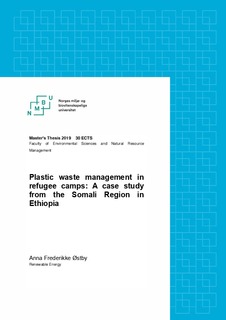Plastic waste management in refugee camps : a case study from the Somali region in Ethiopia
Master thesis
Submitted version
Permanent lenke
http://hdl.handle.net/11250/2625397Utgivelsesdato
2019Metadata
Vis full innførselSamlinger
- Master’s theses (MINA) [668]
Sammendrag
Sustainable waste management is something that has only been studied and developed in a few refugee camps in the world. This thesis, and the project it has been written through, aims to improve the waste management system in some refugee camps by creating value both financially and economically for refugees. The thesis aims to answer the research question “What are the impacts of implementing plastic recycling in refugee camps, primarily focusing on environmental and financial impacts, and what system can be recommended for the camps in the Somali region in Ethiopia based on these considerations?”
This question has been explored through material flow analysis, financial analysis and a Life Cycle Assessment of the recycling system planned through Engineers Without Borders’ fieldwork during the summer of 2018. Plastic waste amount estimates could be provided for PET and HDPE. The 433 000 inhabitants in the whole area, including refugees, villagers and city inhabitants, probably produce about 89 tons of HDPE and 7 tons of PET per month. HDPE is today being recycled in Addis Ababa, while PET is being dumped in open landfills and burned. The exact products chosen to analyse in this study were flower pots and rooftiles. The environmental analysis proved that production based on PET and production of flower pots are the two most feasible choices when evaluating greenhouse gas-emissions. Production of rooftiles from HDPE will most likely contribute to a net increase of greenhouse gases in the atmosphere. Within the other impact categories, the results pointed in different directions, and so did not point out a clear conclusion. The results from the main financial analysis revealed a negative annual result, by several millions of Ethiopian birr, if producing only rooftiles, but a positive annual result if producing only flower pots. However, there is a restriction of 5000 flower pots sold for the price assumed in the analysis. The analysis also showed that production using HDPE was more financially viable than using PET.
When combining these results, and considering other aspects such as possibilities of making PET closer in financial viability to HDPE, in addition to the positive consequences for the refugees by reducing the amount of PET being burned close to the camps and the remaining debris, the conclusion of the thesis is that introducing systematic recycling of only PET, moulded into flower pots, would be the best solution for these camps. Det har foreløpig ikke blitt etablert eller forsket på bærekraftige avfallssystemer i flyktningleirer i noen særlig grad. Denne masteroppgaven og prosjektet den har blitt skrevet gjennom bidrar til at dette feltet blir mer opplyst gjennom å analysere og vurdere økonomiske og samfunnsøkonomiske konsekvenser av å resirkulere plast i flyktningleirer. Forskningsspørsmålet som har blitt besvart gjennom oppgaven er «Hvilke innvirkninger har plastresirkulering i flyktningleirer generelt og spesielt med fokus på miljøet og økonomisk lønnsomhet, samt hvilket system kan bli anbefalt for flyktningleirene i Somaliregonen i Etiopia med hensyn til dette?»
Dette spørsmålet har blitt utforsket gjennom materialstrøm-, kost-nytte- og livsløpsanalyse av dagens system og resirkuleringssystemet som ble planlagt av Ingeniører Uten Grenser etter feltarbeid sommeren 2018. Estimater for mengden av HDPE og PET i omløp i områdene ble anslått til henholdsvis 89 og 7 ton for de 433 000 innbyggerne som bor i både flyktningleirene og vertsbyene. I dag blir HDPE-plasten resirkulert i Addis Abeba, mens PET blir brent på ukontrollerte deponier nær bebyggelse. Produktene basert på den resirkulerte plasten som er brukt i analysen er blomsterpotter og takplater. Livsløpsanalysen viste at produksjon av blomsterpotter og produksjon med PET er de to beste valgene med hensyn til klimagassutslipp. Produksjon av takplater fra HDPE vil på den annen side sannsynligvis føre til en økning av klimagassutslipp fra systemet som helhet. Andre påvirkningskategorier ga varierende svar for hva som ville være den beste løsningen. Resultatene fra den bedriftsøkonomiske analysen viste at systemet med forutsetningene i grunnscenariet ville føre til et årlig tap på flere millioner Etiopiske birr ved produksjon av kun takplater, men en gevinst ved produksjon av kun blomsterpotter. En høy gevinst ved produksjon av kun blomsterpotter er dog ikke realistisk, da UNHCR kun kan kjøpe 5000 blomsterpotter i året til den gitte prisen. Analysen viste også at produksjon med HDPE var mer lønnsomt enn PET med antakelsene gitt i hovedanalysen.
Konklusjonen er at ved å sammenstille de nevnte resultatene i tillegg til å vurdere aspekter som kan gjøre PET nær like lønnsomt som HDPE, samt å inkludere de positive konsekvensene resirkulering av PET vil ha på lokalsamfunnet gjennom reduserte utslipp fra forbrenning og mindre plast i lokalmiljøet, vil opprettelse av et resirkuleringssystem kun for PET være det mest lønnsomme. Produksjonen bør i første omgang være av blomsterpotter, men også andre produkter med samme økonomiske og miljømessige substitusjonsverdi bør vurderes.

